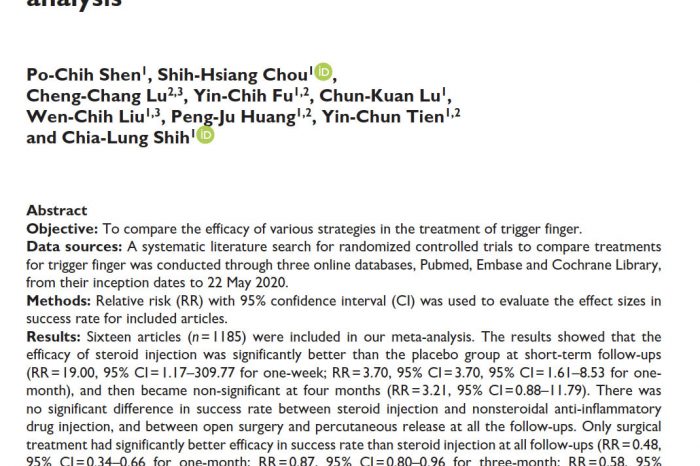
Trigger finger is one of the most common causes of hand pain with a peak age of 50 to 60 years (Weilby 1970). The exact cause of trigger finger is unknown or uncertain, but certain conditions such as diabetes or hypothyroid may predispose an individual to trigger finger (Gil et al, 2020).
Trigger finger can limit the ability to straighten or bend the finger. The digit classically snaps open when a forceful attempt is made to extend the digit. This triggering can be caused by thickening and nodule formation in the tendon. There can also be thickening and stiffening of the A1 pulley. These changes cause abnormal gliding and catching of the tendon within the A1 pulley or tendon sheath (Gil et al, 2020).
Treatments include medications (NSAIDs), physical therapy, steroid injections, percutaneous release and open surgery. Steroid injections can reduce the size of the flexor tendon and A1 pully (Takahashi et al. 2018), and patients are often offered up to 3 injections before considering surgical management. Overall, 52% of patients had spontaneous resolution of symptoms within a year of developing symptoms (McKee et al), and recent systematic reviews found corticosteroids may only provide short-term benefit (Lunsford et al. 2019; Shen et al. 2020).
In some patient physical therapy or steroid injections only provided a short-term effect. Patients that fail to respond to conservative management usually require either an open or percutaneous release of the A1 pulley. Release of the pulley results in 90 to 100% success rates (Everding et al 2015; Bruijnzell et al 2012).
Percutaneous A1 pulley release has been shown to be effective and safe (Gulabi et al 2014; Guo et al 2018). As noted by Gil et al., “at present, many hand surgery training programs do not
provide routine exposure to percutaneous (trigger finger) release.” If you are interested in a percutaneous approach make sure you see a specialist trained in ultrasound and percutaneous approach.
A recent pairwise meta-analysis by Shen et al. (https://pubmed.ncbi.nlm.nih.gov/32539454/) compared how effective these various treatments strategies were for trigger finger (Shen et al. 2020). The results showed no significant difference between steroid injection and physical therapy or NSAID medications.
Surgical treatments had the highest success rate among all treatments with a success rate of >90%. The analysis showed no significant difference between open surgery and a percutaneous minimally invasive trigger finger release (Shen et al. 2020).

Bruijnzeel H, Neuhaus V, Fostvedt S, Jupiter JB, Mudgal CS, Ring DC: Adverse events of open A1 pulley release for idiopathic trigger finger. J Hand Surg Am 2012;37:1650-1656
Everding NG, Bishop GB, Belyea CM, Soong MC: Risk factors for complications of open trigger finger release. HAND 2015; 10:297-300.
Gil JA, Hresko AM, Weiss AC. Current Concepts in the Management of Trigger Finger in Adults. J Am Acad Orthop Surg. 2020 Aug 1;28(15):e642-e650.
Gulabi D, Cecen GS, Bekler HI, Saglam F, Tanju N: A study of 60 patients with percutaneous trigger finger releases: Clinical and ultrasonographic findings. J Hand Surg Eur Vol 2014;39:699-703.
Guo D, McCool L, Senk A, et al: Minimally invasive thread trigger digit release: A preliminary report on 34 digits of the adult hands. J Hand Surg Eur Vol 2018;43: 942-947.
Lunsford D, Valdes K, Hengy S. Conservative management of trigger finger: A systematic review. J Hand Ther 2019;32:212-221.
McKee D, Lalonde J, Lalonde D: How many trigger fingers resolve spontaneously without any treatment? Plast Surg (Oakv) 2018;26:52-54.
Shen PC, Chou SH, Lu CC, Fu YC, Lu CK, Liu WC, Huang PJ, Tien YC, Shih CL. Comparative effectiveness of various treatment strategies for trigger finger by pairwise meta-analysis. Clin Rehabil. 2020 Sep;34(9):1217-1229.
Takahashi M, Sato R, Kondo K, Sairyo K: Morphological alterations of the tendon and pulley on ultrasound after intrasynovial injection of betamethasone for trigger digit. Ultrasonography 2018;37:134-139.
Weilby A. Trigger finger. Incidence in children and adults and the possibility of a predisposition in certain age groups. Acta Orthop Scand. 1970;41(4):419-27.
Adductor longus selective tenotomy is a modern surgical treatment for chronic groin pain that offers faster recovery and better outcomes than traditional full release surgery. The adductor longus, an inner thigh
Read MoreDiscover how ultrasound helps diagnose plantar fat pad atrophy, a leading cause of ball-of-foot pain. Learn about symptoms, thickness cutoffs, and why early detection matters for relief.
Read More